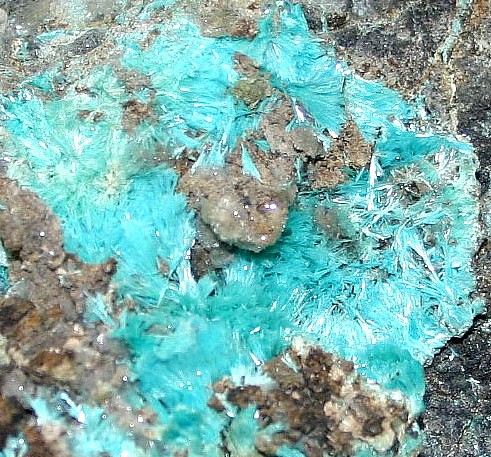|
.
Aurichalcite
Mineral Facts:
Chemical
Formula: (Zn,Cu)5(CO3)2(OH)6
Copper Zinc
Carbonate-Hydroxide.
Colors:
sky blue, blue green, green.
Hardness:
ranges 2
Density:
3.96
Cleavage:
Two
perfect cleavages
parallel to (010)
and (100).
Crystallography: Monoclinic
Commonly found in radiating needle crystals.
Luster:.
Vitreous
luster.
Optics:
(Refractive Index): =
a=1.655;
b= 1.740;
y=1.744 |
 |
|
Composition, Structure and
Associated Minerals:
Aurichalcite is
found as a secondary mineral in deposits in
zinc and
copper
ores. While typically found as radiating sprays of needle like crystals,
it can also be found in crusts or rarely in more compact columnar, laminated
or granular forms. It was first described in 1839, the name means "mountain
copper." in Greek. Associated minerals include:
calcite,
rosasite,
smithsonite, hemimorphite, hydrozincite,
limonite,
malachite
and
azurite.
Identification
and Diagnostics
Aurichalcite
gives
positive tests for both copper and zinc, it is soluble in hydrocloric acid
with emission of carbon dioxide.
It is recognized by the presence of both copper and zinc, its color, crystal form and
its solubility in acids.
|
 |
|
|
Localities
Aurichalcite typically occurs in the oxidized
zone of copper and zinc deposits in locations where carbonates are present
in the wall rocks. Well known international occurrences of Aurichalcite
include Laurium, Greece; Tsumeb, Namibia and Mapimi, Durango, Mexico.
In the US, Aurichalcite is found at the Kelly Zinc mine in New
Mexico, at the 79 Mine, Banner District, Gila County, Arizona, the copper
mines of
Bisbee, Arizona; USA; Salida, Chaffee Co., Colorado,
and at Lucin, Utah. It is a very minor ore of zinc and copper. It is valued
more highly as a mineral specimen because it
makes for attractive, well colored specimens that are highly valued by
mineral collectors.
.Return
to the
Mineral Collectors Information Page
|


